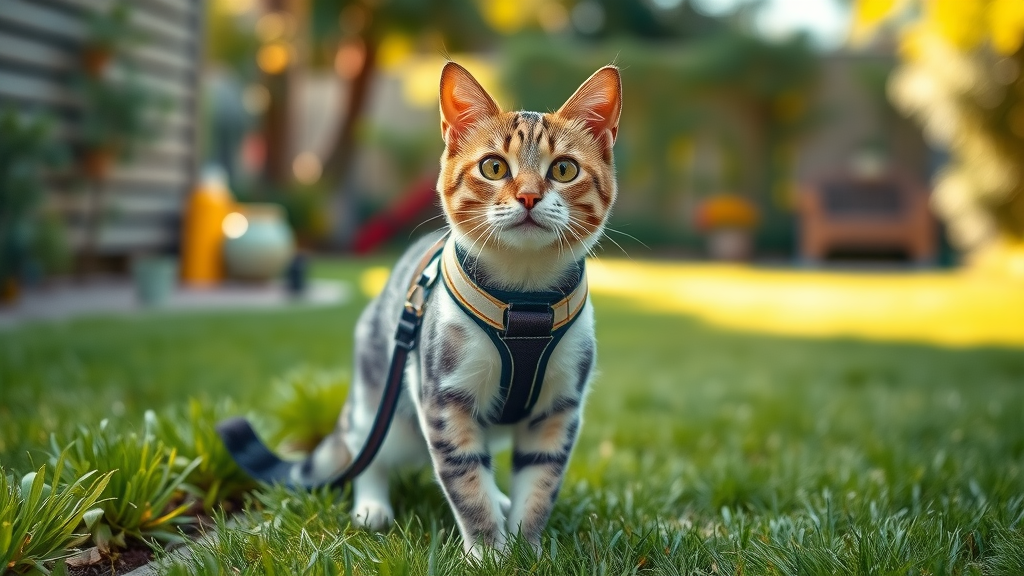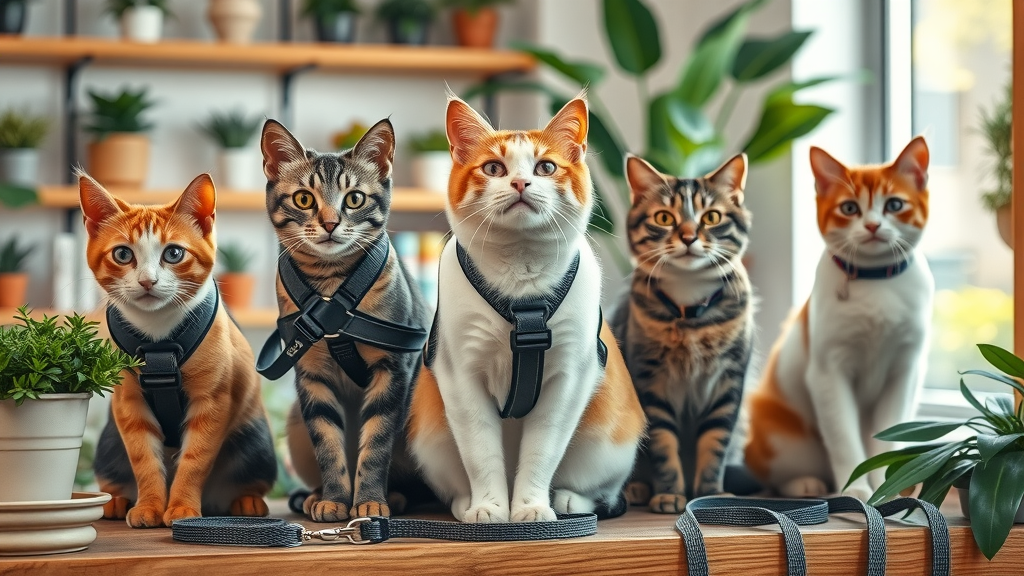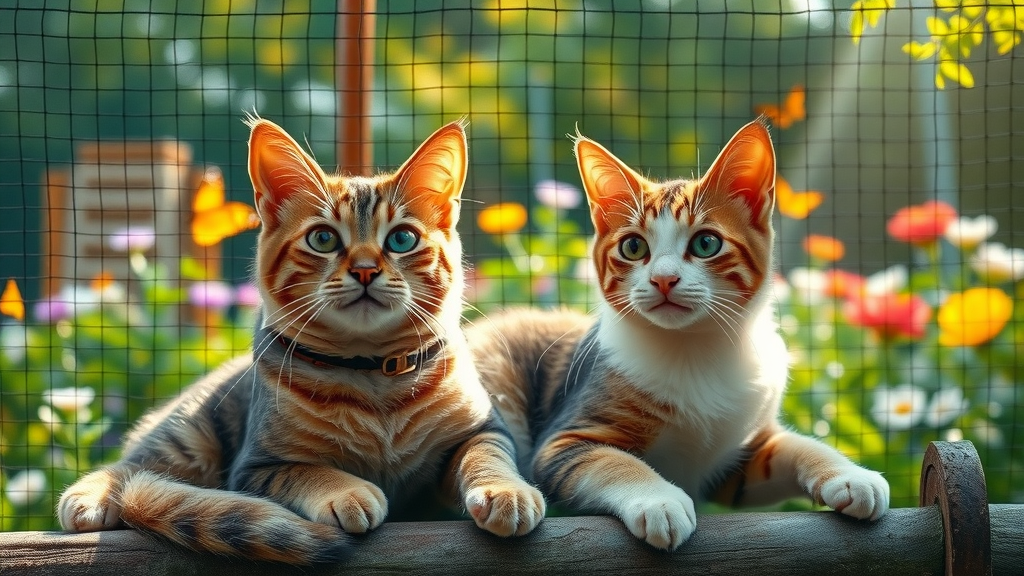- Did you know that only about 5-10% of cat owners attempt leash training, yet those who do often report more active and happier pets? Break the mold—learn how to successfully leash train and walk your cat safely.

Can You Train a Cat to Walk on a Leash? Debunking Myths and Setting Expectations
- Explore the truth behind leash training a cat, common misconceptions, and real-life benefits of harness and leash adventures.
Many people assume cats can’t be leash trained because they're too independent, but this simply isn't true. Just like dogs, cats thrive on mental stimulation and a routine that includes safe outdoor exploration. With the right approach and gear, most cats can learn to enjoy walking on a leash and harness—even if your cat isn’t a kitten anymore. Not only does this break boring routines, but it can also help your feline stay healthy, happy, and less prone to behavioral issues from boredom.
Don’t let outdated myths prevent you from experiencing the joy of walking your cat. Some pet parents worry the process is too stressful, but with positive reinforcement and gentle steps, you’ll likely find your cat adapts—often faster than expected! Walking your cat isn’t about forcing them; it’s about creating positive experiences. Benefits of leash training a cat include increased exercise, new sensory enrichment, and a deeper pet owner bond. Challenging the stereotype opens opportunities for your cat to safely explore the great outdoors.
What to Expect: Leash Training Your Cat
- What you'll learn about can you train a cat to walk on a leash:
- Key benefits of leash train routines for cats
- Essential equipment for harness and leash success
- Step-by-step leash training a cat tips for positive results
- Common hurdles and how to overcome them
- Expert-approved safety measures
Starting leash training your cat opens up a world of new adventures. You’ll notice increased confidence, reduced indoor stress, and enhanced mental stimulation for your cat. This transformation doesn’t happen overnight, so it’s normal for progress to be gradual. As your cat adjusts, expect moments of hesitation, but also playful curiosity as they explore a safe, new environment while harnessed beside you.
The process of teaching your cat to walk on a leash does vary. Some felines adjust in a few weeks, while others might take longer to feel comfortable with their harness and leash. Consistency, patience, and small rewards help set both you and your cat up for success. As you both adapt to your new walking routine, keep in mind that each cat has their own unique pace—your role is to guide, support, and enjoy your evolving adventures together.
Choosing the Right Gear: Harness and Leash Essentials
Selecting the Best Cat Harness and Leash
- Different types of cat harness
- Adjustable vs. fixed length leash
- Comfort, fit, and safety considerations
The foundation of successful leash training a cat is using the right gear. Not all cat harnesses are created equal—there are step-in harnesses, vest-style harnesses, and H-style harnesses. Step-in and vest-style harnesses offer greater security since they're harder for a cat to back out of, while H-style models can be lighter and cooler for warmer climates. Regardless of the type, make sure the harness is designed for cats and fits snugly without pinching or restricting movement.
When choosing a leash, look for options specifically made for felines. An adjustable-length leash gives you control while allowing your cat freedom to explore, while a fixed-length leash might suit urban environments or nervous cats. It's crucial that the hardware is lightweight and secure, and that the connection between harness and leash is reliable—avoid retractable leashes, which can be hazardous due to their sudden tension changes. Always check the fit to ensure your cat is comfortable and can’t slip out.

| Brand/Style | Type | Adjustable? | Best For | User Rating |
|---|---|---|---|---|
| Kitty Holster | Vest | Yes | Escape Artists | 4.7/5 |
| PetSafe Come With Me Kitty | H-style | Yes | Most Cats | 4.4/5 |
| Rabbitgoo Cat Harness | Vest | Yes | Beginner Cats | 4.6/5 |
| PUPTECK Escape Proof | Step-In | Yes | Outdoor Training | 4.3/5 |
"A well-fitted harness is safer and more comfortable for your cat than any collar could ever be." — Certified Cat Trainer
Step-by-Step Guide: How to Leash Train a Cat from Home
Step 1: Preparing Your Cat and Home for Leash Training
- Getting your cat accustomed to wearing a harness
- Creating a positive association with treats and play
- Safety checks and indoor practice
Before you ever attach the leash , let your cat sniff and explore the harness. Place it beside their favorite spots or offer treats as you introduce it. Once your cat seems curious and relaxed, gently put the harness on for a few minutes at a time—never force or rush the process. Use treats, play sessions, or gentle petting to reward your cat for simply wearing the harness, and gradually increase the duration over several days. This lays the groundwork for positive associations every time the harness comes out.
After your cat is comfortable wearing a harness, begin moving around the house together. Encourage movement with toys or treats, allowing your cat to walk naturally without restriction. Do frequent comfort checks: ensure the harness is snug but not tight (you should just fit two fingers beneath it). This safe, controlled environment is perfect for releasing your cat’s initial anxiety and giving them confidence before adding the leash.

Step 2: Introducing the Leash and Encouraging First Walks
- Attaching the leash indoors
- Gentle guidance, not force
- Gradually extending leash time
Once your cat is unfazed by the harness, it’s time to attach the leash —start this process indoors. Allow the leash to trail behind for a few minutes so your cat gets used to its movement. Gradually hold the leash, guiding gently instead of pulling. Remember, the aim is to reward your cat for staying close and moving with you, not to direct their every step. Avoid tightening the leash, and maintain it relatively loose to build trust and comfort.
Gradually increase indoor leash walking time over a week or more, always using praise and food rewards for participation or calm behavior. Monitor your cat’s body language for signs of stress; progress at your cat’s pace is key. These first steps shape your cat’s confidence, laying a positive foundation for outdoor adventure. The better your cat feels comfortable with their harness and leash inside, the smoother the transition will be when it's time for their first taste of the great outdoors.
Step 3: Moving Outside—The Cat’s First Outdoor Walk
- Picking a quiet, safe spot for the first walk
- Understanding cat body language
- Helping your cat feel curious, not anxious
Select a quiet area in your backyard or a calm corner outdoors for your first walk. Carry your cat outside while wearing their harness, then gently set them down. Stay close and keep the leash loose as your cat explores their new environment. Watch for positive curiosity, like sniffing or slow steps, and reassure your cat with gentle words or treats. If your cat seems anxious , don’t pressure them—just sit together and let them take in the sights, smells, and sounds at their own pace.
Quick movements, cars, or unfamiliar animals may cause fear. If your cat wants to retreat, calmly return back inside . Over time, increase outdoor sessions as your cat grows confident . The first few walks outdoors are about building trust and encouraging gentle exploration while using the harness and leash as a safety net—not a restraint. Always end on a positive note with praise or a special treat.
Common Challenges When Training a Cat to Walk on a Leash
Addressing Hesitation and Fear in Cats During Leash Training
- Recognizing signs of distress
- Supporting shy or stubborn cats
- When to pause and try again
Not every cat leaps at the chance to walk on a leash . Signs of stress include crouching, tail tucking, ears back, hissing, or efforts to escape the harness. Be vigilant for these reactions and give your cat space if needed. For nervous or shy cats, break sessions into even smaller steps: put the harness near their sleeping area, reward exploration, or play harness-related games. Slow and steady always wins for training your cat .
If your cat freezes or panics, calmly remove the harness and offer reassurance. Try again later with lower expectations, focusing on comfort and familiarity. Seek out advice from a behavior consultant if your cat struggles for weeks, but remember, progress isn’t always linear—setbacks can be part of the learning process. By reading your cat’s body language and responding to their specific needs, you’ll eventually help them see the leash as a source of adventure, not fear.
Leash Training vs. Harness and Leash Training—What’s the Difference?
- Terminology explained
- Which method is best for your situation
Leash training simply refers to the process of teaching your cat to walk on a leash with you. “Harness and leash training”—often used interchangeably—puts additional emphasis on using a harness for safety, as traditional collars can injure a cat’s neck if they pull or get startled. For felines, harness and leash training is best practice since it minimizes escape risk and keeps your pet comfortable throughout the training.
Some people mistakenly try to leash train with a collar, but cats can slip out easily—always use a cat-specific harness. Choose a training approach based on your cat’s lifestyle: indoor cats may need more gradual transitions, while adventurous personalities might be ready for the great outdoors sooner. The method should always prioritize positive experiences, not force.
Expert Strategies: Tips for Leash Training Your Cat Faster and Easier
- Consistent daily routines
- Positive reinforcement with rewards
- Dos and don'ts of leash training
Consistency is the secret ingredient in leash training your cat . Instead of sporadic sessions, schedule short daily training blocks so your cat can build skills without pressure. Use highly motivating treats (think shredded chicken or store-bought cat snacks) and reward small wins—like tolerating the harness a few minutes longer each day. Never drag or pull your cat; rather, let curiosity guide them naturally, and always keep sessions positive and brief.
It’s important to recognize setbacks are normal. If your cat resists, back up a step and focus on what feels safe. Common mistakes include using a too-tight harness, trying to rush outdoors, or ignoring signs of discomfort. Stay tuned in to your pet’s body language and modify the plan as needed. Remember—success in training your cat means building confidence and trust, not just covering ground.
-
Top 5 pro tips to train a cat to walk calmly on a leash:
- Start leash training early—kittens often adapt faster, but adults can learn too.
- Pair the harness with fun: reward with treats and play during every step.
- Practice in a familiar indoor space before ever stepping outside.
- Keep the leash loose—avoid tension to prevent fear or panic.
- End every training session positively, even if progress is tiny.

Safety, Comfort, and Long-Term Success When You Walk Your Cat
- Identifying hazards indoors and outdoors
- Ensuring physical wellbeing
- How often and how long to walk cats
Safety comes first on every outdoor adventure . Always inspect your harness and leash before use, especially the clips and buckles. While outdoors, steer clear of busy roads, stray animals, and toxic plants. For indoor practice, remove potential snags and supervise your cat while leash training . A secure fit and regular breaks ensure your cat loves their new experience instead of dreading it.
Physical wellbeing matters too; young, healthy cats might love daily strolls, but seniors or cats with health concerns may need shorter, less frequent outings. Most training sessions last 5–20 minutes at the start and can be gradually increased. Watch for signs of fatigue, overheating, or overstimulation, and always offer fresh water and rest back inside . Adapt frequency and duration as your cat is comfortable with the routine.
"The key to successful leash training is patience. Every cat progresses at their own pace." — Animal Behaviorist

Alternatives to Leash Training: Exploring Indoor and Enclosure Options
- Cat backpacks
- Outdoor enclosures (catios)
- Interactive play in safe spaces
Leash training isn’t ideal for every cat wit nerves or those wary of the outdoors. Cat backpacks, which are well-ventilated carriers with clear windows, let your feline see the world while staying safely contained. They’re perfect for pet parents who want to give their cat new experiences without the stress of harnesses or unpredictable outdoor elements.
Outdoor enclosures, affectionately known as "catios," are another enriching option. These mesh structures allow your cat to walk , climb, and explore a secure outdoor space freely. For cats who prefer to stay inside, interactive toys, window perches, and puzzle feeders help deliver mental stimulation and exercise. Whatever option you choose, the goal remains the same: safely giving your cat a richer, more interesting world.

How to Handle Setbacks While Training Your Cat to Walk on a Leash
- Adapting training sessions for progress
- Understanding common reasons for setbacks
- Building trust post-negative experience
Every cat faces obstacles on their leash training journey. Common setbacks include gear aversion, distractions outdoors, or sudden frights. If setbacks occur, pause your training and revisit earlier, successful steps—like wearing the harness indoors or simply rewarding calm behavior. Rebuild trust with patience and never punish or force your cat; gentle encouragement will do more for their confidence than pressure ever could.
Try to understand what triggered your cat’s hesitation. Was it a loud noise, an ill-fitting harness, or just too much newness too fast? Adapting your sessions—whether by simplifying the environment or going slower—shows your cat you’re paying attention to their needs. Backtrack and focus on positive reinforcement to set the stage for renewed progress.
Leash Training Your Cat: Real Owner Stories and Success Cases
"It took time, but now our shy indoor cat looks forward to every walk. The change in her confidence is amazing!" — Cat Owner
Thousands of owners who once doubted their cat could walk on a leash now share inspiring success stories. From nervous rescues blossoming into confident outdoor explorers, to senior cats discovering a new zest for life, leash training transforms routines and relationships. Many pet parents report a noticeable boost in their cat’s overall happiness, less boredom, and newfound trust within the household.
Whether your cat eventually leads the way down leafy trails or just enjoys sunbathing on a leash in your backyard, the process is as rewarding for you as it is for your feline. Each step is a celebration of teamwork, patience, and the joy of experiencing the world together—one safe adventure at a time.
People Also Ask About Can You Train a Cat to Walk on a Leash?
Is it okay to walk a cat on a leash?
- Yes, it's perfectly okay and even beneficial for many cats, as long as you use the right harness and follow safety protocols for leash training a cat.
How long does it take to train a cat to walk on a leash?
- It varies—some cats adapt within weeks, while others may take several months. Patience, consistency, and positive reinforcement are crucial for leash training success.
At what age is it too late to train a cat?
- There's no strict age limit. Young cats may learn faster, but adult and even senior cats can be leash trained with gentle, patient steps.
Should I take my indoor cat on walks?
- Walking your cat can enrich their environment and improve mental/physical health, but always assess your individual cat's personality and needs.
FAQ: Most Common Questions on Can You Train a Cat to Walk on a Leash?
-
What if my cat refuses to wear a harness?
Try gradual desensitization—introduce the harness near meals and play, and reward your cat for exploring or sniffing it. Progress slowly, always rewarding calm behavior. -
How tight should the harness fit?
It should be snug but not restrictive. You should fit two fingers easily between the harness and your cat’s body for both security and comfort. -
Are there breeds better suited for leash training?
Active and adventurous breeds (like Bengals, Maine Coons, or Abyssinians) often take to leash training faster, but any healthy cat can learn with patience. -
Can kittens be leash trained?
Yes! In fact, kittens adapt quickly—just remember their bones and joints are developing, so keep sessions brief and gentle. -
What are signs my cat is ready to walk outdoors?
Signs include relaxed body language while harnessed, curiosity when the leash is attached, and comfort exploring on-leash inside.
Key Takeaways for Cat Owners on Leash Training
- Every cat is unique—customize your approach
- The right gear matters for safety
- Leash training takes time and rewards patience
- Outdoor walks provide incredible enrichment
Ready to Try Leash Training? Why Walking Your Cat Can Change Your Routine
- Want expert advice, trending products, and must-know health tips for your pet? 📬 Join our free monthly newsletter — made for pet lovers, by pet lovers.
Training your cat to walk on a leash can be a rewarding experience, offering both mental stimulation and physical exercise for your feline friend. To ensure success, it’s essential to use the right equipment and follow a gradual training process.
For a comprehensive guide on leash training, consider the San Francisco SPCA’s article, Leash Training (Cats) . This resource provides detailed steps, from selecting the appropriate harness to introducing your cat to outdoor environments safely.
Additionally, the VCA Animal Hospitals’ article, Train your cat to walk on a leash , offers practical advice on acclimating your cat to a harness and leash, emphasizing the importance of patience and positive reinforcement throughout the training process.
By consulting these resources, you’ll gain valuable insights and step-by-step instructions to help your cat enjoy safe and enjoyable outdoor adventures.
 Add Row
Add Row  Add
Add 




Write A Comment